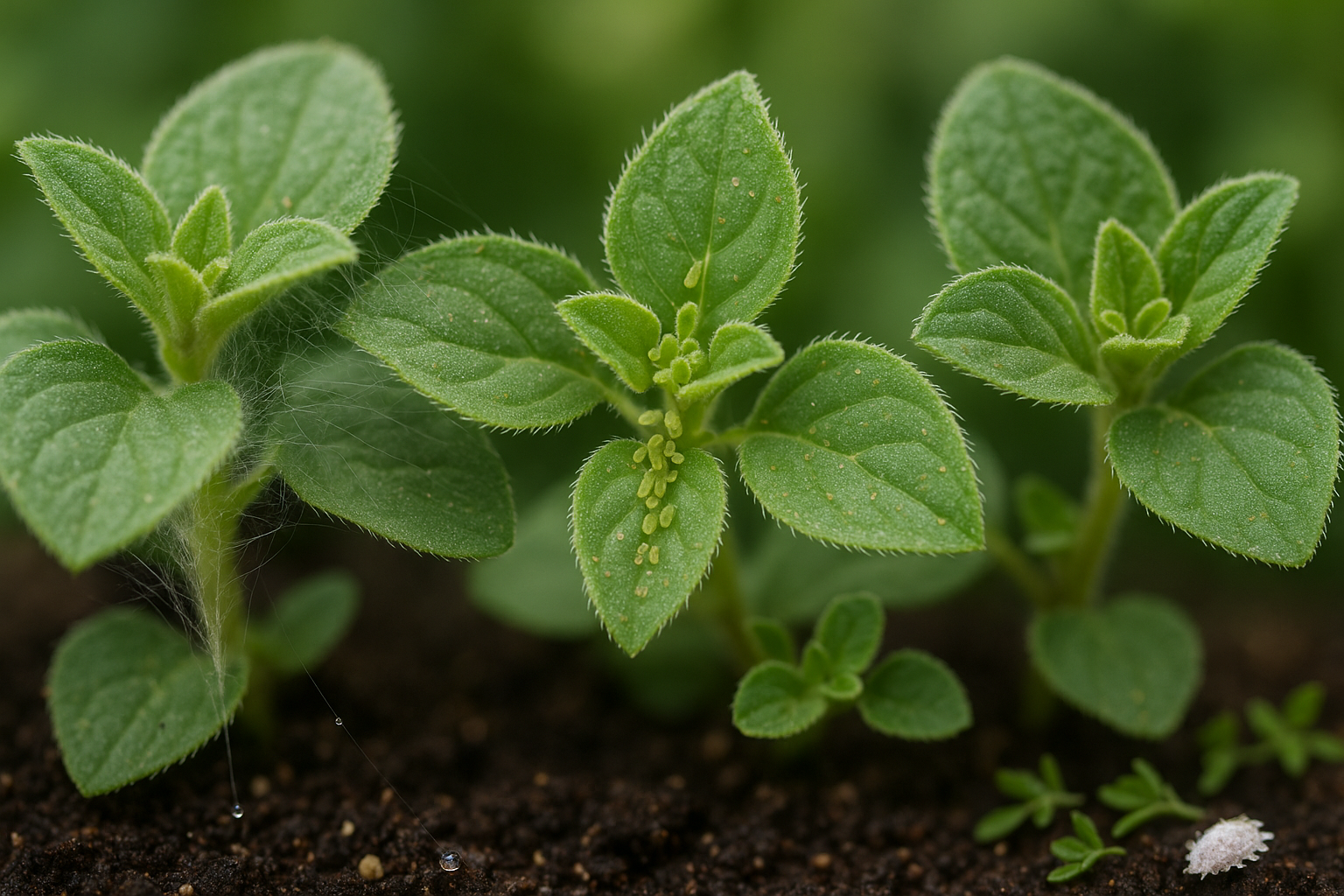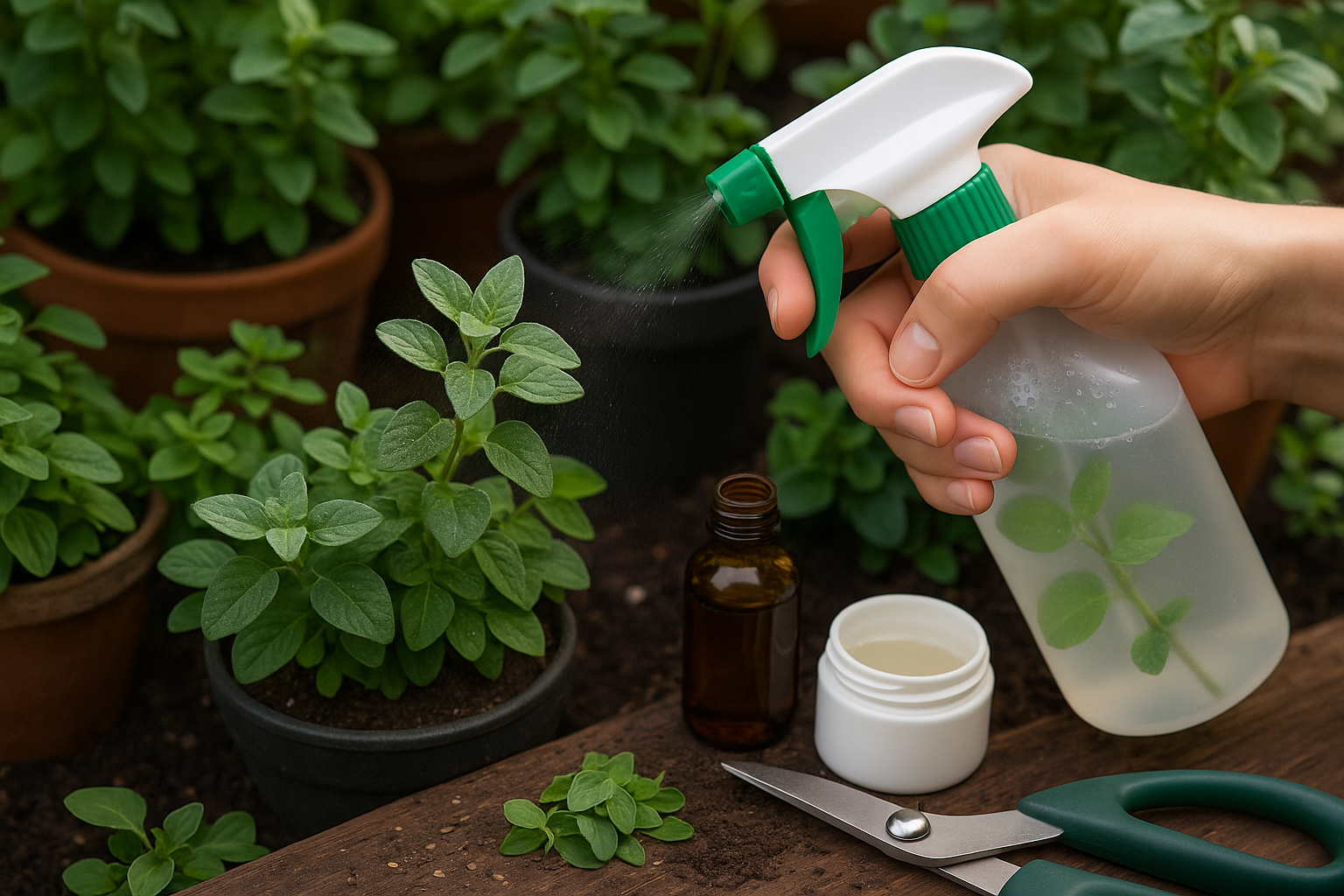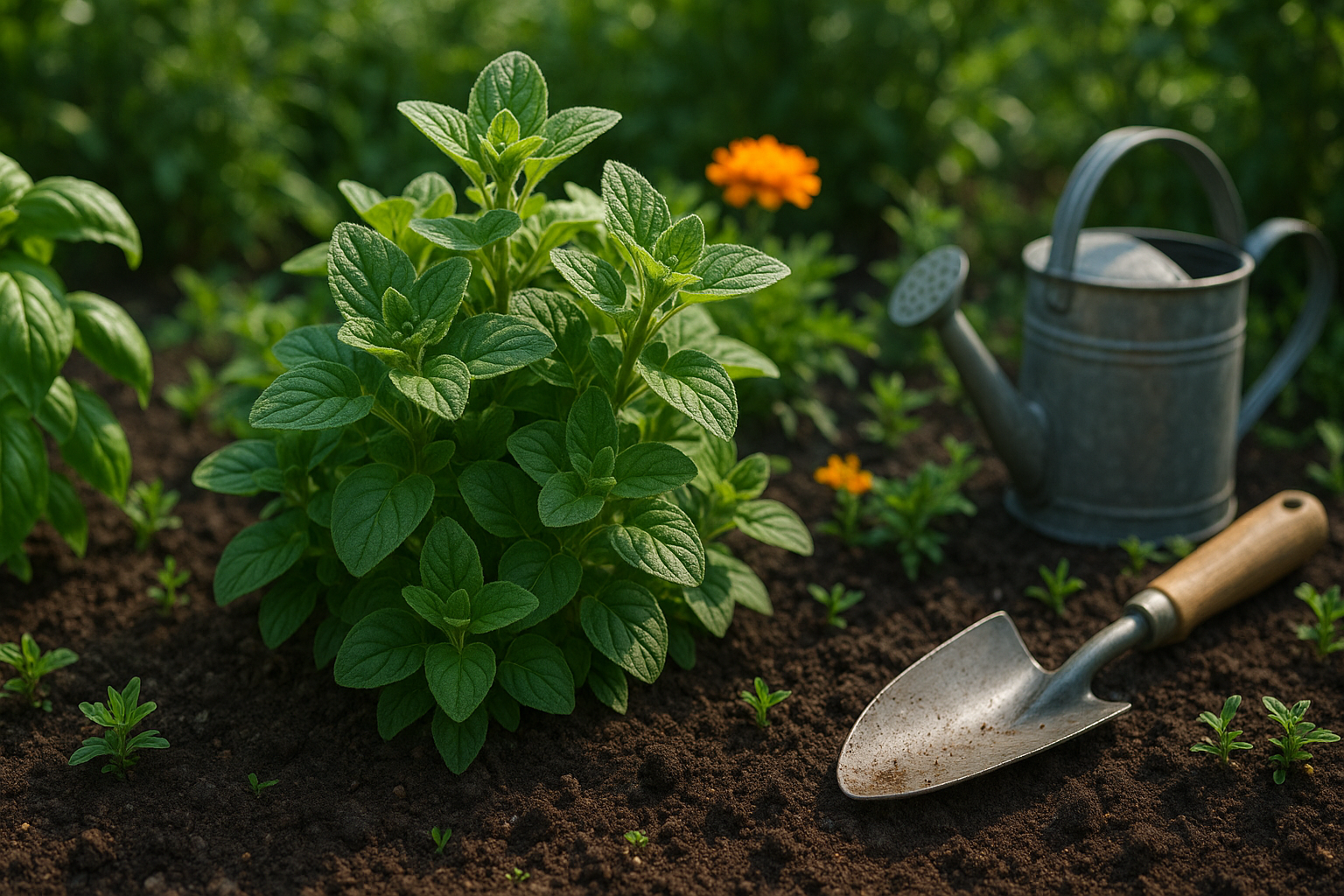Introduction
Oregano is a staple in home gardens and kitchens worldwide, cherished for its robust flavor and health benefits. However, dealing with oregano pests can quickly turn your thriving herb patch into a source of frustration. Pests not only stunt growth but also compromise the quality and taste of your oregano, making effective control essential for a healthy, productive plant.
Instead of reaching for harsh chemicals, there are plenty of natural and eco-friendly ways to keep these invaders at bay. Simple strategies like companion planting, regular leaf inspections, and using gentle homemade sprays can make a real difference. For example, planting oregano alongside basil or marigold can help deter unwanted bugs.
By focusing on natural solutions, you protect both your herbs and the surrounding environment, ensuring your oregano remains a safe and delicious addition to your meals.
Common Oregano Pests and How to Recognize Them

Oregano is generally a hardy herb, but it isn’t immune to pest problems. Some of the most common culprits include spider mites, aphids, scale insects, mealybugs, fungus gnats, and fruit flies.
You’ll often find spider mites by their fine, sticky webbing on the undersides of leaves or between stems; leaves may also look speckled or faded as these tiny pests suck out the sap. Aphids, the classic garden pest, tend to cluster on new growth, leaving sticky “honeydew” behind, which can attract ants and cause sooty mold to form.
Scale insects appear as small, round, brown or white bumps attached to stems or leaf joints, blending in so well they almost look like part of the plant—but if you scratch at them, they come off. Mealybugs are easier to spot, showing up as cottony white clusters in stem crevices or leaf axils.
Fungus gnats are tiny black flies hovering around the soil, and their larvae might nibble on roots, leading to stunted growth. Fruit flies might gather around overly wet soil or decomposing plant matter, signaling excessive moisture.
Tips for Early Pest Detection
Inspect your oregano plant closely at least once a week—pay special attention to the undersides of leaves and hidden stems. Look for any discoloration, curling, holes, sticky residues, webbing, or unusual spots. You can gently shake a few leaves over a sheet of white paper; if tiny bugs fall onto it, you might have a pest issue starting.
How to Protect Your Oregano
Swiftly isolating infested plants and trimming off damaged growth helps stop pests from spreading. Practicing good watering habits and ensuring adequate airflow around your oregano keeps the environment less inviting for pests, protecting your herbs before an infestation takes hold.
Spider Mites on Oregano – Natural Solutions

Spider mites can be tricky to spot on oregano until you notice their telltale signs: delicate, fine webbing draped over stems and leaves, and foliage that appears speckled, yellowed, or otherwise discolored. If you see tiny moving dots on the undersides of leaves, you’re probably dealing with these pesky mites.
Early detection is key, so check your oregano often, especially during hot, dry weather when mite populations thrive.
To naturally get rid of spider mites, start by spraying your plants with a strong stream of water—this simple method helps knock mites and eggs off the leaves, disrupting their life cycle. After rinsing, apply neem oil or insecticidal soap to the affected areas; both target spider mites without harming your oregano or beneficial insects. Reapply every few days to catch new hatchlings.
For ongoing prevention, try to keep humidity around your oregano a bit higher, as spider mites prefer dry environments—grouping potted herbs together or misting the area occasionally can help. Also, avoid over-fertilizing, which produces soft new growth that mites love.
Regularly inspect both sides of the leaves to catch infestations early, and consider introducing natural predators like ladybugs or predatory mites if you garden outdoors. By combining these practical steps, you’ll give your oregano the best chance to stay healthy and spider mite–free, all without resorting to harsh chemicals.
Managing Aphids and Mealybugs Organically
Aphids and mealybugs are common pests that can seriously harm oregano plants if left unchecked. These tiny insects feed by sucking sap from the leaves and stems, causing distorted growth, yellowing, and even stunted plants. Mealybugs often leave behind a sticky residue called honeydew, which attracts ants and encourages the growth of sooty mold, further damaging the health and appearance of your oregano.
Organic management is both effective and eco-friendly. Start by regularly inspecting your oregano, especially the undersides of leaves where pests like to hide. If you spot small infestations, gently remove the insects by hand or use a stream of water to dislodge them.
Spraying plants with a mild soapy water solution (one teaspoon of mild liquid soap per quart of water) can suffocate soft-bodied pests without harming the plant—just be sure to rinse the leaves with clean water after a few hours. Introducing beneficial insects, such as ladybugs or lacewings, is another natural way to keep aphid and mealybug populations under control; these predatory insects actively hunt and consume pests, providing ongoing protection.
Preventative Care
Preventative measures are key to maintaining healthy oregano plants:
- Prune oregano regularly to remove overcrowded foliage, which increases air circulation and makes it harder for pests to hide and multiply.
- Ensure proper plant spacing when planting or transplanting oregano so each plant receives good airflow and sunlight.
- Maintain healthy, unstressed plants by keeping your oregano well-watered (but not soggy) and nourished with compost or organic fertilizer.
By combining these organic practices, you can enjoy vigorous, pest-free oregano for culinary and herbal use.
Coping with Scale Insects, Fungus Gnats, and Fruit Flies
Scale insects, fungus gnats, and fruit flies can all trouble your oregano plants, but each pest brings its own challenges and signs. Scale insects look like tiny brown or white bumps clinging to oregano stems and leaves, sapping sap and leaving a sticky residue called honeydew that attracts ants or sooty mold.
To spot fungus gnats, watch for tiny black flies hovering around the soil and check for clear, wiggly larvae just beneath the surface — they love moist, rich potting mix and feed on oregano roots, which can cause stunted, yellowing growth. Fruit flies, on the other hand, are drawn to overripe or decaying leaves and organic matter, often appearing in kitchens or greenhouses if plant debris isn’t cleared away.
Natural Control Methods
Natural control methods can work wonders:
- Scale insects: Dip a cotton swab in isopropyl alcohol and gently dab each insect — the alcohol dissolves their protective coating and kills them on contact. Be careful not to soak the leaves, as this can harm the plant.
- Fungus gnats: Let the top inch of soil on your oregano dry out between waterings, since larvae need moisture to survive. Sticky yellow traps placed near the soil catch adult gnats before they can lay eggs, reducing the population over time.
- Fruit flies: Fill a small dish with apple cider vinegar and a drop of liquid soap to break surface tension — the scent attracts flies, but they’ll fall in and drown.
Prevention Tips
Prevent future infestations by tweaking growing conditions:
- Remove dead leaves and debris from the soil surface.
- Avoid overwatering.
- Ensure light and airflow reach your oregano patch.
- Never let organic matter pile up, as it attracts fungus gnats and fruit flies.
With regular checking and quick intervention, you can keep your oregano thriving and beat back these pesky intruders naturally.
Preventative Tips for Healthy, Pest-Free Oregano
Keeping your oregano plants healthy and pest-free starts with a few simple but essential cultural practices. First, always plant oregano in well-drained soil—soggy roots invite pests and diseases. To boost air circulation, avoid overcrowding your plants and trim them regularly; this reduces humidity around the leaves and discourages problems like fungal gnats or aphids.
Companion planting can also help: try growing oregano near tomatoes, peppers, or basil. These combinations often confuse pests and naturally repel them, making it harder for bugs to find their target.
Stay proactive by inspecting your oregano every few days, paying close attention to the undersides of leaves where pests tend to hide. If you notice any leaves that look wilted, discolored, or chewed, remove them right away to prevent issues from spreading.
For non-toxic pest deterrence, consider spraying a mild solution of water and dish soap to gently wash away small infestations, or use neem oil, which is both effective and safe for edible herbs.
Lastly, practice good garden hygiene—clear away dropped leaves and stems from around your oregano, and sanitize tools between uses to prevent the accidental spread of diseases.
By sticking to these habits, you’re not only protecting your oregano but encouraging a thriving, resilient herb garden overall.
When to Act
Monitoring your oregano plant for pest issues starts with regular, close inspection. Check beneath leaves, at stem joints, and around the soil for bugs or signs of damage such as holes, yellowing, or curled leaves.
If you spot only a few pests or mild symptoms, natural methods like hand-picking bugs, rinsing with water, or using homemade sprays (such as diluted neem oil or soap solution) are usually enough. It’s important to observe your plant over the next week—recovering oregano should show new, undamaged growth and stabilized foliage.
If you still see pests or worsening damage after two weeks of regular eco-friendly treatments, or if entire sections of the plant begin wilting, it may be time to escalate your response. Keep in mind that patience is key with natural pest control; improvements can take time, and too much intervention can stress your plant further.
Documenting your progress with notes or photos helps track changes, so you can spot persistent problems early. If you notice rapid decline, increasing pest numbers, or spread to nearby plants despite your efforts, consider seeking advice from a local gardening expert or extension office before resorting to harsher chemical controls.
Remember, consistency and careful observation are your best allies in managing oregano pests responsibly while protecting pollinators and maintaining a healthy garden ecosystem.
Conclusion
Using natural pest control for oregano not only keeps your herb healthy but also supports a thriving, eco-friendly garden. By relying on methods like introducing beneficial insects, practicing crop rotation, and making homemade sprays, you minimize harmful chemicals and promote a balanced ecosystem.
This approach boosts your oregano’s growth and helps other plants flourish, attracting pollinators and maintaining soil health at the same time. Remember, consistent preventive care—such as regular checks for early signs of pests, removing debris, and ensuring proper spacing—can stop problems before they start.
Observing your plants closely lets you act quickly and avoid major outbreaks. Have you tried natural pest control methods in your garden? We’d love to hear what’s worked for you, any creative tips you’ve discovered, or questions you have. Share your experiences in the comments—let’s grow better gardens together!
